当代国外翻译理论导读第六章女性主义翻译理论.
- 格式:ppt
- 大小:138.50 KB
- 文档页数:56

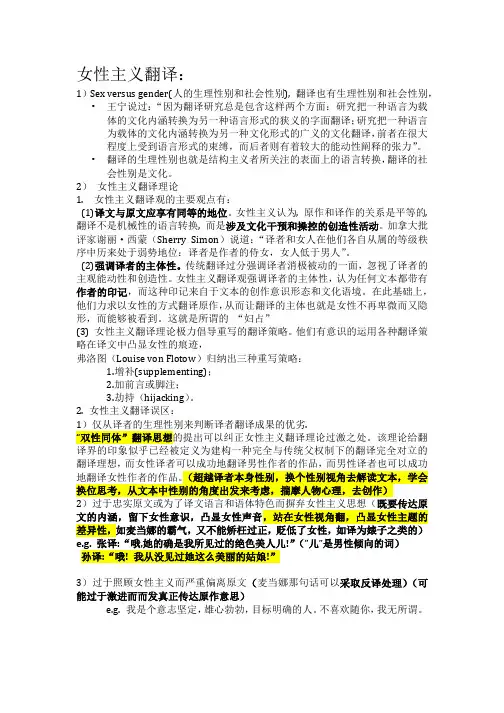
女性主义翻译:1)Sex versus gender(人的生理性别和社会性别), 翻译也有生理性别和社会性别,•王宁说过:“因为翻译研究总是包含这样两个方面:研究把一种语言为载体的文化内涵转换为另一种语言形式的狭义的字面翻译;研究把一种语言为载体的文化内涵转换为另一种文化形式的广义的文化翻译,前者在很大程度上受到语言形式的束缚,而后者则有着较大的能动性阐释的张力”。
•翻译的生理性别也就是结构主义者所关注的表面上的语言转换,翻译的社会性别是文化。
2)女性主义翻译理论1. 女性主义翻译观的主要观点有:(1)译文与原文应享有同等的地位。
女性主义认为, 原作和译作的关系是平等的, 翻译不是机械性的语言转换, 而是涉及文化干预和操控的创造性活动。
加拿大批评家谢丽·西蒙(Sherry Simon)说道:“译者和女人在他们各自从属的等级秩序中历来处于弱势地位:译者是作者的侍女,女人低于男人”。
(2)强调译者的主体性。
传统翻译过分强调译者消极被动的一面,忽视了译者的主观能动性和创造性。
女性主义翻译观强调译者的主体性,认为任何文本都带有作者的印记,而这种印记来自于文本的创作意识形态和文化语境。
在此基础上,他们力求以女性的方式翻译原作,从而让翻译的主体也就是女性不再卑微而又隐形,而能够被看到。
这就是所谓的“妇占”(3) 女性主义翻译理论极力倡导重写的翻译策略。
他们有意识的运用各种翻译策略在译文中凸显女性的痕迹,弗洛图(Louise von Flotow)归纳出三种重写策略:1.增补(supplementing);2.加前言或脚注;3.劫持(hijacking)。
2. 女性主义翻译误区:1)仅从译者的生理性别来判断译者翻译成果的优劣.“双性同体”翻译思想的提出可以纠正女性主义翻译理论过激之处。
该理论给翻译界的印象似乎已经被定义为建构一种完全与传统父权制下的翻译完全对立的翻译理想,而女性译者可以成功地翻译男性作者的作品,而男性译者也可以成功地翻译女性作者的作品。
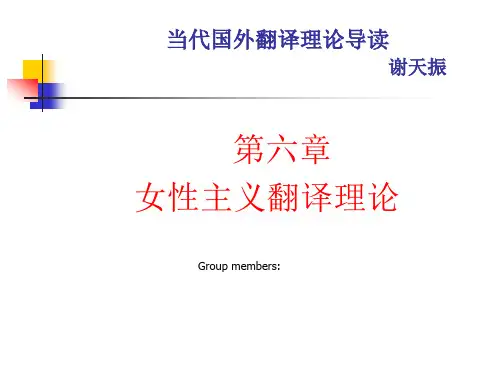
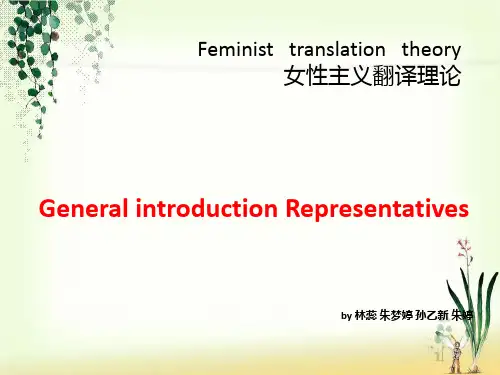
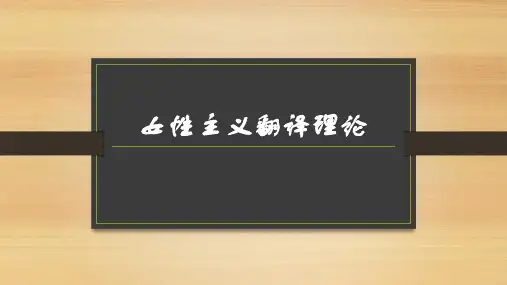
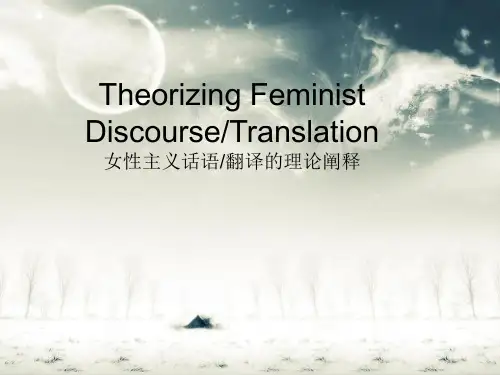
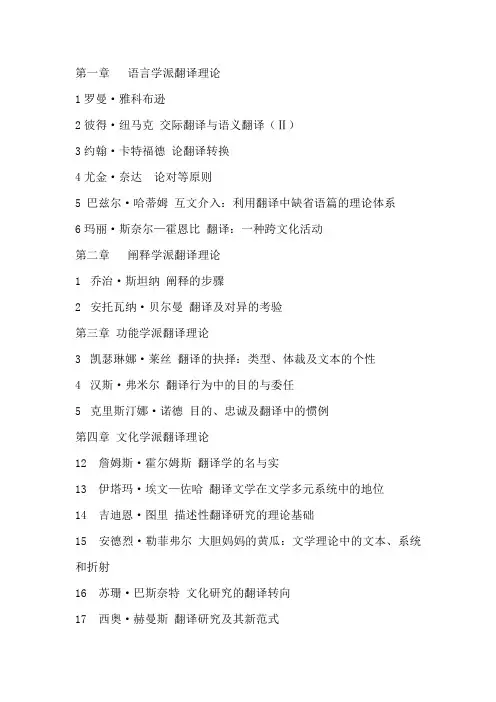
1罗曼·雅科布逊2彼得·纽马克交际翻译与语义翻译(Ⅱ)3约翰·卡特福德论翻译转换4尤金·奈达论对等原则5 巴兹尔·哈蒂姆互文介入:利用翻译中缺省语篇的理论体系6玛丽·斯奈尔—霍恩比翻译:一种跨文化活动第二章阐释学派翻译理论1乔治·斯坦纳阐释的步骤2安托瓦纳·贝尔曼翻译及对异的考验第三章功能学派翻译理论3凯瑟琳娜·莱丝翻译的抉择:类型、体裁及文本的个性4汉斯·弗米尔翻译行为中的目的与委任5克里斯汀娜·诺德目的、忠诚及翻译中的惯例第四章文化学派翻译理论12 詹姆斯·霍尔姆斯翻译学的名与实13 伊塔玛·埃文—佐哈翻译文学在文学多元系统中的地位14 吉迪恩·图里描述性翻译研究的理论基础15 安德烈·勒菲弗尔大胆妈妈的黄瓜:文学理论中的文本、系统和折射16 苏珊·巴斯奈特文化研究的翻译转向17 西奥·赫曼斯翻译研究及其新范式18 瓦尔特·本雅明译者的任务19 雅克·德里达巴别塔之旅20.保罗·德曼评本雅明的《译者的任务》21.劳伦斯·韦努蒂文化身份的塑造第六章女性主义翻译理论22.雪莉·西蒙翻译理论中的性别化立场23.劳丽·钱伯伦性别与翻译的隐喻24.巴巴拉·格达德女性主义话语/翻译的理论化25.冯·弗罗托女性主义翻译理论批评第七章后殖民翻译理论26.道格拉斯·罗宾逊后殖民研究与翻译研究27.特佳斯维妮·尼南贾纳翻译的定位28.盖亚特里·斯皮瓦克翻译的政治29.埃尔斯·维埃拉解放卡利班们——论食人说与哈罗德·德·坎波斯的超越/越界性创造诗学第八章苏东学派翻译理论30.安德烈·费奥多罗夫翻译理论的任务31.吉维·加切奇拉泽文学翻译中的创造性原则32.吉里·列维翻译是一个作选择的过程33.安娜·丽洛娃翻译研究的范畴6Roman Jakobson论翻译的语言学问题“On Linguistic Aspectsof Translation”布拉格语言学派创始人罗曼·雅科布逊1959年发表的《论翻译的语言学问题》首先将语言学、符号学引进了翻译学,他把语言分为“语内翻译(Intralingual Translation)、语际翻译(Interlingual Translation) 和符际翻译(Intersemiotic Translation)”(三分法理论)。
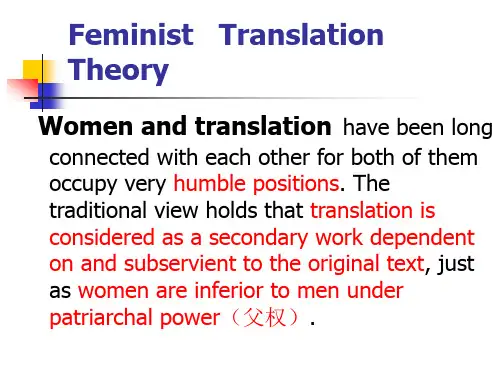
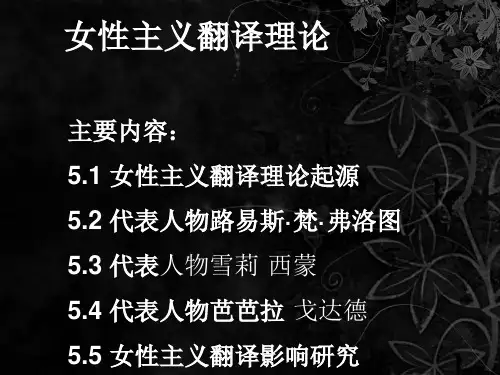
![[女性主义,翻译,理论,其他论文文档]女性主义翻译理论观](https://uimg.taocdn.com/efd4228f4afe04a1b071def9.webp)
女性主义翻译理论观女性主义翻译理论观女性主义翻译理论观女性主义翻译理论观精品源自生物科20世纪60年代,女权主义运动在西方风起云涌。
这场由知识女性发起的意识形态的战争,波及到了政治、文化、文学等社会上层建筑的各个方面,更推动了女性主义在学术领域的发展。
翻译研究者从中找到了女性主义与翻译的相似点,认为翻译中存在严重的性别歧视问题,开始质疑暗含男性中心论的译论。
由此,女性主义翻译观应运而生。
一、女性主义与翻译两千多年来,翻译领域充斥着各式各样的性别隐喻,如,把翻译比作“不忠的美人”。
翻译被置于与女性相同的地位。
原作对于再生产的译本所具有的等级上的权威与阳性和阴性的意象连接在了一起:原作被视为强壮而具有生产力的男性,而译本则是低弱的派生女性。
西方女性主义翻译理论家认为,翻译处于这种弱势地位是长期受父权压制的结果。
父权中心制统治下的翻译研究移植了社会文化中男尊女卑的性别伦理,使翻译这种跨文化的语言活动也被视为从属、派生的部分,进而被女性化和边缘化。
女性与翻译在共同的历史境遇上找到了相似点和类比的基础,从而引发了两者相互结合的可能(徐翠波,2011,p.60)。
二、理论主张女性主义和翻译都是对语言的一种批判性理解,当二者结合起来时,便形成了一种全新的翻译理论。
女性主义为翻译研究提供了一个全新研究的视角,它对传统翻译理论中的一些重要概念进行了全新的诠释,提出了独特的观点和见解。
其主要观点包括:(1)对传统翻译理论标准“忠实”的颠覆,强调叛逆 (2)重新界定译文与原作的关系,突显译者主体性女性主义翻译理论打破了传统的“作者/原作-译者/译文”的两元对立模式,提倡原作-译文的共生共荣。
这首先表现在翻译延伸了原作的生命,使得它得以在另一个语言文化空间中面对新的读者群体。
也就是本雅明所说的译文是原作的后续的生命 (afterlife),译文为原作开启了一个更加广阔的生存空间。
女性主义翻译理论家们提出“性别译者”(feminist translator)的概念,首先肯定了译者性别差异所导致的对原文文本意义阐释过程中的不同,从而丰富了原文文本的内涵;同时也提高了译者的主体性并肯定了译者在翻译过程中的创造性。
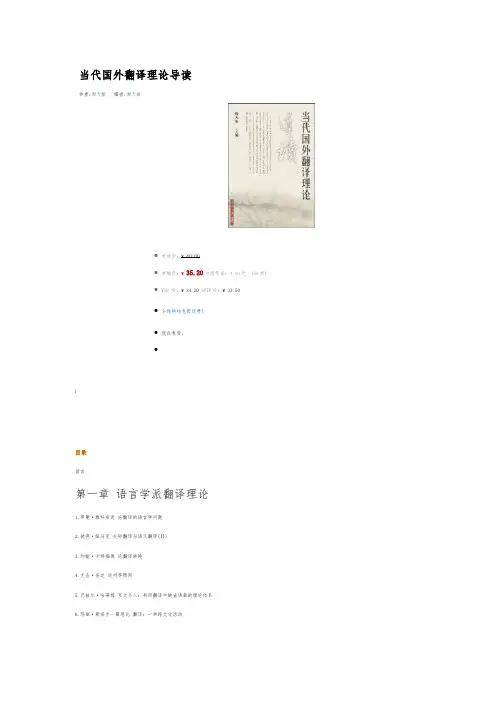
当代国外翻译理论导读作者:谢天振编者:谢天振•市场价:¥40.00•卓越价:¥35.20为您节省:4.80元(88折)•VIP 价:¥34.20 SVIP价:¥33.50•全场购物免配送费!•现在有货。
•)目录前言第一章语言学派翻译理论1.罗曼·雅科布逊论翻译的语言学问题2.彼得·纽马克交际翻译与语义翻译(Ⅱ)3.约翰·卡特福德论翻译转换4.尤金·奈达论对等原则5.巴兹尔·哈蒂姆互文介入:利用翻译中缺省语篇的理论体系6.玛丽·斯奈尔—霍恩比翻译:一种跨文化活动第二章阐释学派翻译理论7.乔治·斯坦纳阐释的步骤8.安托瓦纳·贝尔曼翻译及对异的考验第三章功能学派翻译理论9.凯瑟琳娜·莱斯翻译的抉择:类型、体裁及文本的个性10.汉斯·弗米尔翻译行为中的目的与委任11.克里斯汀娜·诺德目的、忠诚及翻译中的惯例第四章文化学派翻译理论12.詹姆斯·霍尔姆斯翻译学的名与实13.伊塔玛·埃文—佐哈翻译文学在文学多元系统中的地位14.吉迪恩·图里描述性翻译研究的理论基础15.安德烈·勒菲弗尔大胆妈妈的黄瓜:文学理论中的文本、系统和折射16.苏珊·巴斯奈特文化研究的翻译转向17.西奥·赫曼斯翻译研究及其新范式第五章解构学派翻译理论18.瓦尔特·本雅明译者的任务19.雅克·德里达巴别塔之旅20.保罗·德曼评本雅明的《译者的任务》21.劳伦斯·韦努蒂文化身份的塑造第六章女性主义翻译理论22.雪莉·西蒙翻译理论中的性别化立场23.劳丽·钱伯伦性别与翻译的隐喻24.巴巴拉·格达德女性主义话语/翻译的理论化25.冯·弗罗托女性主义翻译理论批评第七章后殖民翻译理论26.道格拉斯·罗宾逊后殖民研究与翻译研究27.特佳斯维妮·尼南贾纳翻译的定位28.盖亚特里·斯皮瓦克翻译的政治29.埃尔斯·维埃拉解放卡利班们——论食人说与哈罗德·德·坎波斯的超越/越界性创造诗学第八章苏东学派翻译理论30.安德烈·费奥多罗夫翻译理论的任务31.吉维·加切奇拉泽文学翻译中的创造性原则32.吉里·列维翻译是一个作选择的过程33.安娜·丽洛娃翻译研究的范畴Translation Theory(2007-09-29 14:13:41)标签:学习公社translationenglishtheoryTranslation TheoryBy Juan Daniel Pérez VallejoTranslation teacher,University of Cd. Del Carmen, Campeche, MexicoThe study of proper principle of translation is termed as translation theory. This theory, based on a solid foundation on understanding of how languages work, translation theory recognizes that different languages encode meaning in differing forms, yet guides translators to find appropriate ways of preserving meaning, while using the most appropriate forms of each language. Translation theory includes principles for translating figurative language, dealing with lexical mismatches, rhetorical questions, inclusion of cohesion markers, and many other topics crucial to good translation. Basically there are two competing theories of translation. In one,the predominant purpose is to express as exactly as possible the full force and meaning of everyword and turn of phrase in the original, and in the other the predominant purpose is to produce a result that does not read like a translation at all, but rather moves in its new dress with the same ease as in its native rendering. In the hands of a good translator neither of these two approaches can ever be entirely ignored. Conventionally, it is suggested that in order to perform their job successfully, translators should meet three important requirements; they should be familiar with: the source languagethe target languagethe subject matterBased on this premise, the translator discovers the meaning behind the forms in the source language and does his best to produce the same meaning in the target language - using the forms and structures of the target language. Consequently, what is supposed to change is the form and the code and what should remain unchanged is the meaning and the message. (Larson, 1984)One of the earliest attempts to establish a set of major rules or principles to be referred to in literary translation was made by French translator and humanist Étienne Dolet, who in 1540 f ormulated the following fundamental principles of translation ("La Manière de Bien Traduire d’une Langue en Aultre"), usually regarded as providing rules of thumb for the practicing translator:The translator should understand perfectly the content and intention of the author whom he is translating. The principal way to reach it is reading all the sentences or the text completely so that you can give the idea that you want to say in the target language because the most important characteristic of this technique is translating the message as clearly and natural as possible. If the translation is for different countries besides Mexico, the translator should use the cultural words of that country. For example if he/she has to translate ”She is unloyal with her husband” in this country it can be translated as “Ella le pone los cuernos” but in Peru it can be translated as “Ella le pone los cachos”. In this case it is really important the cultural words because if the translator does not use them correctly the translation will be misunderstood.The translator should have a perfect knowledge of the language from which he is translating and an equally excellent knowledge of the language into which he is translating. At this point the translator must have a wide knowledge in both languages for getting the equivalence in the target language, because the deficiency of the knowledge of both languages will result in a translation without logic and sense. For example if you translate the following sentence “Are you interested in sports?” as “¿Estás interesado en deportes?” the translation is wrong since the idea of this question in English is “¿Practicas algún deporte?”The translator should avoid the tendency to translate word by word, because doing so is to destroy the meaning of the original and to ruin the beauty of the expression_r. This point is very important and one of which if it is translated literally it can transmit another meaning or understanding in the translation.For example in the sentence.- “In this war we have to do or die”, if we translate literally “En esta guerra tenemos que hacer o morir” the message is unclear. The idea is, (.) “En esta guerra tenemos que vencer o morir.”The translator should employ the forms of speech in common usage. The translator should bear in mind the people to whom the translation will be addressed and use words that can be easily understood.Example. “They use a sling to lift the pipes” if the translation is to be read by specialists we would translate it “Utilizan una esling a para levantar la tubería”. If the text is to be read by people who are not specialists we would rather translate it “Utilizan una cadena de suspension para levantar los tubos”.Flip to Text Version La Trobe UniversityHarry AvelingA Short History of Western Translation Theory1. Traditional Translation TheoriesThere is a continuity of intellectual expression from Ancient Greece, Rome, the Middle Ages, through to the Renaissance, the Reformation, and the rise of the early European nation states. The central language of scholars and other readers was Latin, while the core of this tradition was classicalliterature and Judeo-Christianity. There was a profusion of economic and political contacts throughout Europe and the Middle East, and this must have involved an abundance of linguistic transactions. Nevertheless, Lefevere"s words provide an accurate background to understanding the social position of the subjects of traditional translation theory: "In such a culture, translations were not primarily read for information or the mediation of the foreign text. They were produced and read as exercises, first pedagogical exercises, and later on, as exercises in cultural appropriation - in the conscious and controlled usurpation of authority." (Lefevere 1990: 16).2. German RomanticismAt the beginning of the nineteenth century, a second, more philosophical and less empirical, formation began to open within discourses on translation theory (Munday 2001: 27). This formation was connected, in one direction, with the rise of philology as a university discipline, and in another with the literary movement of Romanticism. Philology provided a range of new and exotic texts and allowed the experts to produce translations aimed primarily at other experts, not the general culture of which these scholars were a part (Lefevere 1990: 22). Romanticism exalted the translator "as a creative genius in his own right, in touch with the genius of his original and enriching the literature and language into which he is translating" (Bassnett-McGuire 1980: 65). The stress on both the original author and the translator as being artists was not part of traditional discourse formations.3. The Early and Middle Twentieth CenturyDiscussion in English of translation theory during the first half of the twentieth century continued to be dominated by the themes of Victorian discourse on translation, "literalness, archaizing, pedantry and the production of a text of second-rate literary merit for an elite minority" (Bassnett-McGuire 1980: 73). In his list of major contributors to the area of translation theory, Steiner recognises only the names of Dryden, Quine and Pound among English-speakers. Quine and Pound both belong to the twentieth century and challenged the dominant discourse. Willard V. Quine (b. 1908), a major American philosopher, wrote on "the indeterminacy of translation" within the field of linguistic philosophy (Quine 1960). Ezra Pound (1885-1972) was a poet and critic. Ronnie Apter has argued that Pound made three major innovations to thinking about "the nature and intent of literary translation…he discarded the Victorian pseudo-archaic translation diction; he regarded each translation as a necessarily limited criticism of the original poem; and he regarded good translations as new poems in their own right" (Apter 1987: 3).More radical, and more decisive, developments in translation theory took place in Europe. These begin with the Russian Formalist movement, whichfocused on the "what makes literary texts different from other texts, what makes them new, creative, innovative" (Gentzler 1993: 79). One of their answers was that literary texts rely on a process of "defamiliarisation", using language in new and strikingly different ways from ordinary speech. This led the Formalist to focus on "surface structural features" and "to analyse them to learn what determines literary status" (Gentzler 1993: 79). In so doing, they began the search for descriptive rules, which would help scholars understand the process of translation, and not normative rules, in order to study and assess the work of other translators (Bell 1991: 12). Their work was extended and refined by the Prague school of linguistics, founded by Roman Jakobson, who had earlier worked in Moscow. In his essay "On the Linguistic Aspects of Translation" (1959), Jakobson expanded traditional discourse of "equivalence" into the theme of "equivalence in difference". In so doing, he argued that words should be seen within their (arbitrary) semiotic context, and that "the grammatical pattern of a language (as opposed to its lexical stock) determines those aspects of each experience that must be expressed in the given language" (Venuti 2000: 114).4. Translation StudiesThree factors worked to limit this sharp focus on descriptive linguistics as the major form of discourse on translation. The first was the questioning of Chomsky"s linguistic theories by linguists themselves. The second was the development of a number of new and dynamic fields within linguistics, such as "discourse analysis, text linguistics, sociolinguistics, computational linguistics, prototype semantics, and other assorted wonders" (Pym 1992: 184). These "wonders" took in prior fields such as British social anthropology and American cultural anthropology, as well as contemporary and parallel developments in philosophy, information and communication theories, computational linguistics, machine translation, artificial intelligence, and the ideas of socio-semiotics as developed within French structuralist and post-structuralist thought (Nida 2001: 110). The sense increased that: "Language is not the problem. Ideology and politics are…" (Lefevere 1990: 26). This has led to a separation between linguistic and cultural approaches to translation in the last quarter of the twentieth century. For some translation scholars, indeed, it has seemed that "strictly linguistic theories have been superseded, [as] translation has come to be considered in its cultural, historical and sociological context" (Woodsworth 1998: 100).Basic Knowledge of Translation TheoryI.Translation1.Definition1)The definition in the old daysl“译即易,谓换易言语使相解也。
【女性主义翻译理论探索】女性主义翻译理论当今世界是一个多元化的体系,各种理论构成了多元的格局。
作为一种社会活动,翻译被人们从多个视角进行描述,其中最醒目的当属女性主义理论。
女性主义理论对翻译的解释为翻译理论与实践的发展起到了巨大的推动作用,同时也促进了自身与翻译的结合,并最终催生了女性主义翻译理论。
20世纪90年代以来,女性主义翻译理论引起了翻译界的广泛关注,它为翻译研究提供了一个全新的视野和思路,推动着翻译理论研究和实践活动在新的多元体系下迅速发展。
然而,迄今为止女性主义翻译理论远没有达到完善的程度,就我国而言,翻译界直到2000年才开始接触到该理论,因此时至今日,我们很有必要对女性主义翻译理论做进一步的深入探讨,从而使其尽快地融入到中国翻译理论研究与实践当中。
基于此,本文对女性主义翻译理论的产生、内涵及国内外研究现状进行分析,进而探索我国对其研究的不足,希望能够引发更多的有关于该理论的探讨,从而促进我国翻译理论在多元体系中的发展。
一产生:女性主义与翻译结合女性主义翻译理论是女性主义与翻译的有机结合,而此二者的结合有着悠久的历史渊源和广泛的理论基础。
一方面,在历史上翻译和女性一直处于比较低下的地位:前者被认为是鹦鹉学舌、“传话筒”,译文是有缺陷的,必须对原文亦步亦趋绝对忠实,后者被看做是由男性的一根肋骨造出来的“第二性”,因而是男性的一部分,必须严格遵守“三纲五常”,服从于男性;在18世纪的西方,女性没有话语权,她们没有参与写作活动的权利,更没有任意发表言论的自由,因此,翻译曾一度成为女性接触外界、表达自我的唯一窗口;此外,人们还经常把翻译比作女性,认为翻译就像女性一样“漂亮的不忠诚,忠诚的不漂亮”,对翻译与女性的评判仅停留在两个层面,即其外表和对男性(原文)的忠实与服从。
另一方面,在20世纪90年代“文化转向”思潮的影响之下,翻译向着文化这个更加宽广的文化领域进军,为翻译与女性主义的结合提供了广阔的空间;20世纪80年代以来,女性主义运动空前高涨,女性主义者开始意识到,要彻底改变女性的“第二性”、“他者”地位,争取女性的话语权,就要彻底结构男权话语从而颠覆男权社会。
论女性主义翻译理论女性主义翻译理论上世纪60年代末、70年代初,在美国兴起的女权运动对之后30年内的学术与文艺发展,都产生了深远的影响。
女权主义思想在社会中的普及和蔓延,促进了语言的发展。
两者相互交织,相互促进。
也是在同一时期,翻译研究逐渐被接纳为文化研究的重要部分。
由此,文化间性别角色的差异在语言中的体现和表达,以及通过翻译将这些表达植入不同的文化背景等种种错综复杂的问题,成为翻译工作者、关注女性发展、研究女权运动的学者关注的焦点。
一女性主义翻译理论的形成背景1 女性主义翻译理论的形成有其深刻的社会背景及理论渊源。
(1)女性主义又称女权主义。
20世纪,席卷欧美并波及世界其它地区的女性主义运动,使人们尤其是女性意识到这个世界的父权性质,发现了性别不平等的现实,进而要求性别平等和女性独立。
随后,女性主义作为一种意识形态,以性别作为文学批评和研究的切入点,强调女性的主体意识,并用女性的主体意识重新审视整个社会文化和历史传统,突破一系列传统范畴和价值尺度,致力于揭示女性在历史、社会、文化中从属的根源,以达到发掘女性话语、重建文化研究新理论的目标。
她们认为女性必须获得语言的解放,她们做了大量的工作,力求消除语言中的性别歧视。
在语言消除性别歧视之后,她们敏锐的视角很快延伸到翻译领域。
(2)女性与翻译隐喻2000多年来,中西文化中,女性形象一直被歪曲。
同样,在翻译理论与实践中,原作者、原文可比拟为男性、阳性、主动的;译者、译文都被比拟为女性、阴性、被动的。
翻译常被比喻为女性,而且比喻中常带有对女性的歧视。
德莱顿认为译者是原作者的奴隶,奴隶只能在别人的庄园里劳动,给葡萄追肥整枝,然而酿的酒却属于别人。
巴托认为译者处于从属地位,原作者是主人,译者只是仆人,只能紧跟原作者忠实地再现和反映原作的思想和风格,不能逾越仆人的身份进行创作,不能进行任何修改和删减。
法国的梅那日称一些不顾原文风格、随意增改原文的翻译为“不忠的美人”;随后贝尔特朗也说到,“翻译好比美人,美丽的不忠实,忠实的不美丽”。